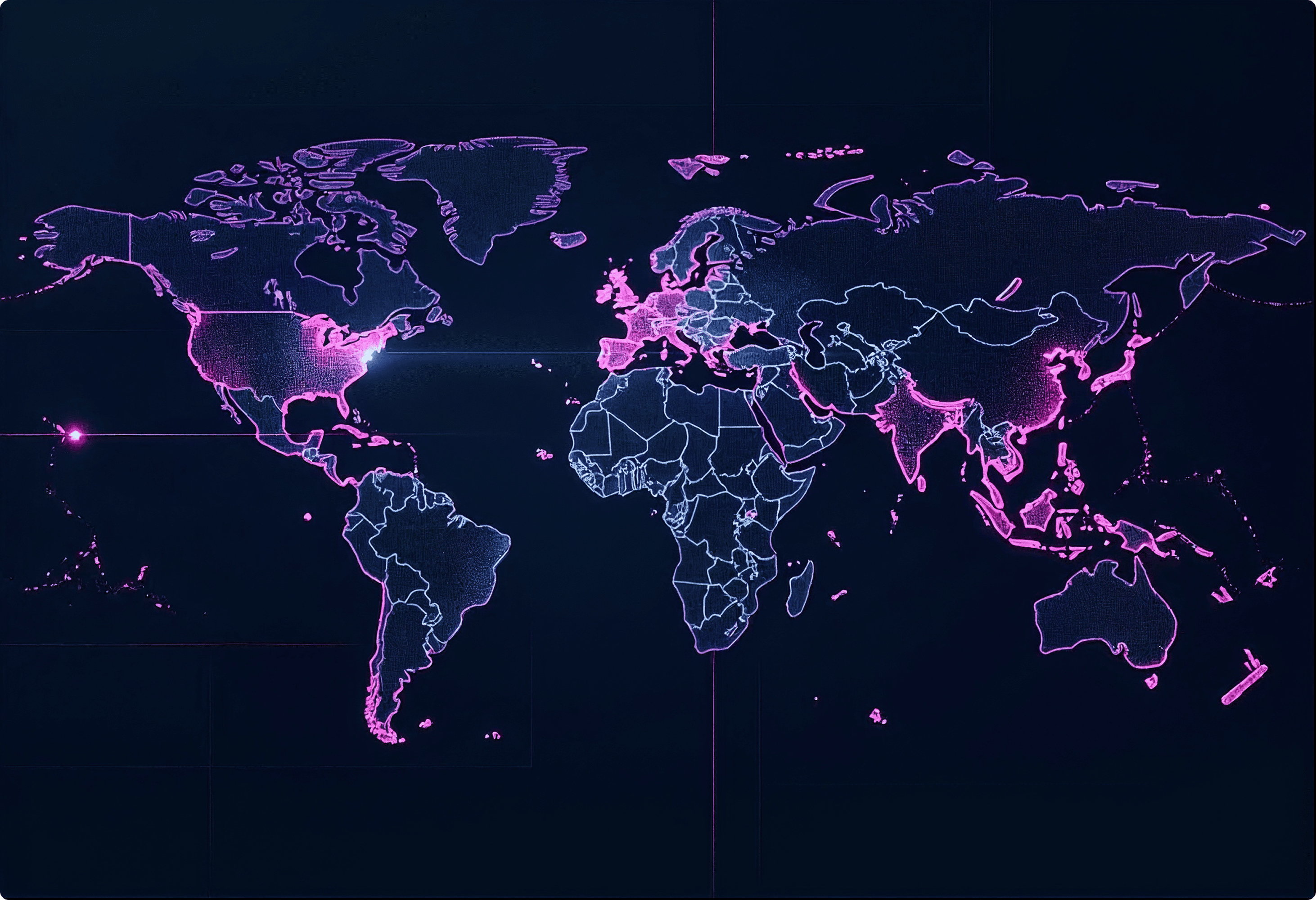Remote Asset Management: Technologies for Distributed Operations
How modern telemetry systems, remote monitoring, and diagnostics platforms enable full visibility, predictive control, and reduced downtime across global operations.

TL;DR
Remote asset management has evolved from basic GPS tracking to integrated telemetry ecosystems that fuse IoT data, analytics, and AI diagnostics. These systems let you control distributed operations in real time, reduce failures, and optimize resource allocation.
Highlights
- End-to-end visibility through advanced remote monitoring and asset tracking networks.
- Predictive uptime using remote diagnostics powered by telemetry systems and machine learning.
- Operational efficiency achieved via unified dashboards and automated maintenance workflows.
Introduction
When Shell upgraded its offshore oil platforms in the North Sea, engineers no longer needed to fly in by helicopter for inspections. Each pump, valve, and sensor now streams telemetry data through a secure edge gateway to a digital dashboard in Aberdeen. Predictive models flag anomalies before they cause downtime — saving an estimated $20 million annually in avoided production loss.
Yet, for every success like this, dozens of companies struggle to make remote operations work. A 2024 IoT Analytics report found that only 38% of organizations with remote asset monitoring initiatives had achieved continuous data flow and actionable insights across all sites. The rest hit walls — fragmented systems, unreliable connectivity, or dashboards that tell more stories than truths.
The technology itself isn’t new: remote monitoring, asset tracking, and telemetry systems have existed for years. What’s changed is the scale, complexity, and expectation. Distributed operations now span continents, edge devices, and real-time decisions. The question is no longer “Can we collect the data?”, but “Can we trust and act on it instantly?”
Fragmented Data, Fragile Insight
For many organizations, remote asset management starts with good intentions and ends with disconnected dashboards. Fleet operators deploy GPS trackers, plants add IoT sensors, and field teams use handheld apps — yet none of these systems talk to each other. The result: data silos that hide context rather than reveal it.
Telemetry data from compressors, turbines, or trucks often travels through different protocols (Modbus, MQTT, OPC-UA), creating compatibility chaos. A simple question like “Which unit is about to fail?” can require merging spreadsheets, API calls, and manual validation. In distributed networks, every extra data hop increases latency and weakens trust in the numbers.
The second bottleneck lies in visualization. Dashboards were meant to simplify decisions, but most overwhelm users with raw metrics and static alerts. Without correlation between sensor data, location, and maintenance history, even the best-looking interface becomes a passive screen, not an operational tool.
Finally, security and connectivity remain nontrivial. In mining, energy, and utilities, over 60% of remote assets still rely on low-bandwidth or intermittent satellite links. That makes real-time remote diagnostics unreliable, especially when every lost packet may hide a critical signal.
In short: companies have the data, but not the integration, reliability, or intelligence to turn it into performance.
The real transformation happens when data stops being observed and starts making decisions.
— Satya Nadella, CEO of Microsoft
Building Connected Intelligence
The foundation of effective remote asset management is not more sensors — it’s system cohesion. Leading companies are moving from isolated monitoring tools to unified telemetry architectures that merge data, context, and analytics into one operational layer.
1. Unified Telemetry Layer
Modern telemetry systems act as translators between field devices and analytics platforms. By using open standards like MQTT and OPC-UA, they normalize input from heterogeneous assets — from old PLCs to smart sensors — and feed it into a central data lake or edge platform.
2. Edge Intelligence
Instead of pushing every signal to the cloud, edge computing nodes preprocess and filter telemetry data near the source. This reduces bandwidth usage by up to 70% and enables remote diagnostics even during connectivity loss. Edge AI models can detect vibration anomalies or thermal deviations in milliseconds, triggering local alerts and corrective actions.
3. Digital Twin Integration
Digital twins have become the visualization core for distributed operations. They synchronize sensor data with 3D models of physical assets, providing contextual insights — not just numbers. When paired with remote monitoring, this allows teams to simulate maintenance scenarios, forecast wear, and optimize production schedules.
4. Secure Cloud Dashboards
The final layer connects insights to humans. Scalable dashboard platforms (like Grafana, AWS IoT SiteWise, or Azure Digital Twins) allow customizable KPIs, automated maintenance tickets, and predictive performance analytics — unifying data into a single pane of truth.
Old Control vs. Smart Visibility
Early-generation SCADA (Supervisory Control and Data Acquisition) systems built the foundation for remote asset control — but they were never designed for the scale, flexibility, or real-time analytics demanded today. The new generation of telemetry-driven platforms changes that.
| Feature / Aspect | Traditional SCADA Systems | Modern Telemetry Architectures | Key Advantage |
| Data Flow | Centralized, polled periodically | Continuous streaming via MQTT / REST | Real-time responsiveness |
| Integration | Vendor-locked, custom protocols | Open APIs, multi-device support | Easy interoperability |
| Remote Monitoring | Limited dashboards and alerts | Unified dashboards with context layers | Full visibility |
| Remote Diagnostics | Reactive fault detection | Predictive analytics and AI models | Reduced downtime |
SCADA remains essential for control and compliance layers, while modern telemetry frameworks deliver the analytical and predictive capabilities needed for distributed operations. Together, they create the hybrid infrastructure that defines next-generation remote asset management.
Real Implementation Case
Rio Tinto – Smart Mining Fleet

Challenge: Rio Tinto’s Pilbara operations manage over 400 autonomous haul trucks across vast mining zones, where unexpected drivetrain or tire failures can halt production for hours.
Approach: The company deployed a private LTE telemetry network linking each truck to a central analytics hub powered by AWS IoT. Continuous vibration, fuel, and tire-pressure data streams are analyzed in real time by edge-based diagnostic models. These models detect drivetrain anomalies hours before they escalate.


Results: The system reduced unplanned maintenance events by 27%, improving fleet utilization and saving several million dollars annually in downtime and labor costs.
Key lesson: Edge diagnostics outperform purely cloud-based analytics for remote operations with limited connectivity and latency-sensitive assets.

From Pilot to Full Deployment
Building an effective remote asset management ecosystem requires more than connecting sensors. Success depends on structured rollout — aligning infrastructure, security, and analytics from day one. The following roadmap summarizes a proven five-phase sequence used by leading industrial and logistics companies.
| Phase | Key Actions | Deliverables | Stakeholders |
| 1. Assessment & Mapping | Audit current asset base, communication protocols, and data flows. Identify integration gaps and telemetry readiness. | Asset inventory, system architecture map | CTO, Field Ops, IT |
| 2. Connectivity Layer | Deploy gateways, configure telemetry systems (MQTT, OPC-UA), and ensure edge connectivity. Test data integrity. | Secure data pipeline, live sensor feeds | Network & IoT Engineers |
| 3. Platform Integration | Connect telemetry layer to analytics dashboards and cloud storage. Apply remote monitoring and asset tracking logic. | Unified dashboard prototype | DevOps, Data Team |
| 4. Predictive Layer | Implement remote diagnostics models. Integrate anomaly detection and alert workflows with maintenance systems. | Predictive alerts, ML model reports | Data Scientists, Reliability Eng. |
| 5. Continuous Optimization | Refine KPIs, automate reporting, and benchmark uptime vs. performance baselines. | Operational dashboard, SLA tracking | Management, Analytics Team |
Each phase builds measurable maturity: from fragmented visibility to predictive insight. The shift happens when telemetry data becomes actionable — not just collected — across all asset classes.
Watch: Provides a comparative review of top endpoint management platforms like NinjaOne and ManageEngine. Useful for discussing telemetry, patching, and device health across remote sites: 5 Best Endpoint Management Software Systems 2025.
Pitfalls and Best Practices
Remote asset management projects often fail not because of technology, but because of implementation blind spots. Below are the most frequent pitfalls — and the proven countermeasures that keep distributed operations reliable.
1. Fragmented Ownership
- Pitfall: Engineering teams deploy sensors without IT or data governance alignment. The result is isolated systems with unclear accountability.
- Best Practice: Create a cross-functional telemetry team combining operations, cybersecurity, and data engineering. Define ownership for connectivity, data quality, and alert response.
2. Overengineering Dashboards
- Pitfall: Teams design dashboards with hundreds of metrics, most of which add noise instead of insight.
- Best Practice: Limit to five to seven KPIs tied directly to uptime, utilization, or safety. Use contextual drill-downs instead of overwhelming displays.
3. Ignoring Data Latency
- Pitfall: Centralized cloud analytics without edge processing cause 2–5 second lag — unacceptable for critical assets.
- Best Practice: Deploy edge AI nodes to filter and process signals locally, forwarding only high-value events.
4. Security as an Afterthought
- Pitfall: Remote gateways often use default credentials or outdated firmware. A single breach can expose the entire telemetry network.
- Best Practice: Enforce zero-trust architecture, regular patching, and VPN-based device onboarding from the start.
5. No Lifecycle Plan
- Pitfall: Projects stall after the pilot phase due to budget or unclear ROI.
- Best Practice: Define a three-year roadmap with quantifiable metrics (MTBF improvement, downtime reduction) to secure ongoing investment.
Sustainable remote operations depend on discipline — consistent governance, lean design, and feedback loops that connect data quality with business outcomes.
Key Insights
- Telemetry integration drives reliability. Unified telemetry systems and standardized data protocols turn fragmented assets into coherent, real-time networks.
- Predictive monitoring reduces cost. Combining remote monitoring with remote diagnostics detects issues early, minimizing downtime and extending asset life.
- Visibility equals control. Consistent asset tracking across sites transforms operations from reactive maintenance to proactive optimization.
Related Resources
How to Choose a Web Development Company in the USA — and Why the Market Is Evolving Faster Than Ever
Select a web partner able to unify remote telemetry, secure long‑haul data pipelines, and deliver production dashboards and APIs.
Total Productive Maintenance (TPM): Digital Transformation Guide
Explore TPM 4.0 strategies for engaging operators, digitizing workflows, and boosting OEE across your operations.
Preventive Maintenance Programs: Planning and Optimization Guide
Learn how to design cost-effective PM programs and optimize service intervals to reduce downtime and expenses.
Conclusion
The evolution of remote asset management reflects a larger shift in industrial technology — from connected devices to connected intelligence. What once required field engineers and manual reports is now executed through self-learning telemetry systems and predictive dashboards that operate continuously across continents.
The technical foundation is already here: secure connectivity, scalable cloud platforms, and accessible AI toolkits. The challenge for most organizations is adopting them with discipline and clarity — aligning data models, ownership, and workflows before scaling.
For leaders managing distributed operations, the goal is no longer visibility alone. It’s decision autonomy — enabling assets to detect, report, and even act before humans intervene. Companies that master this feedback loop will define the next decade of operational resilience and digital efficiency.